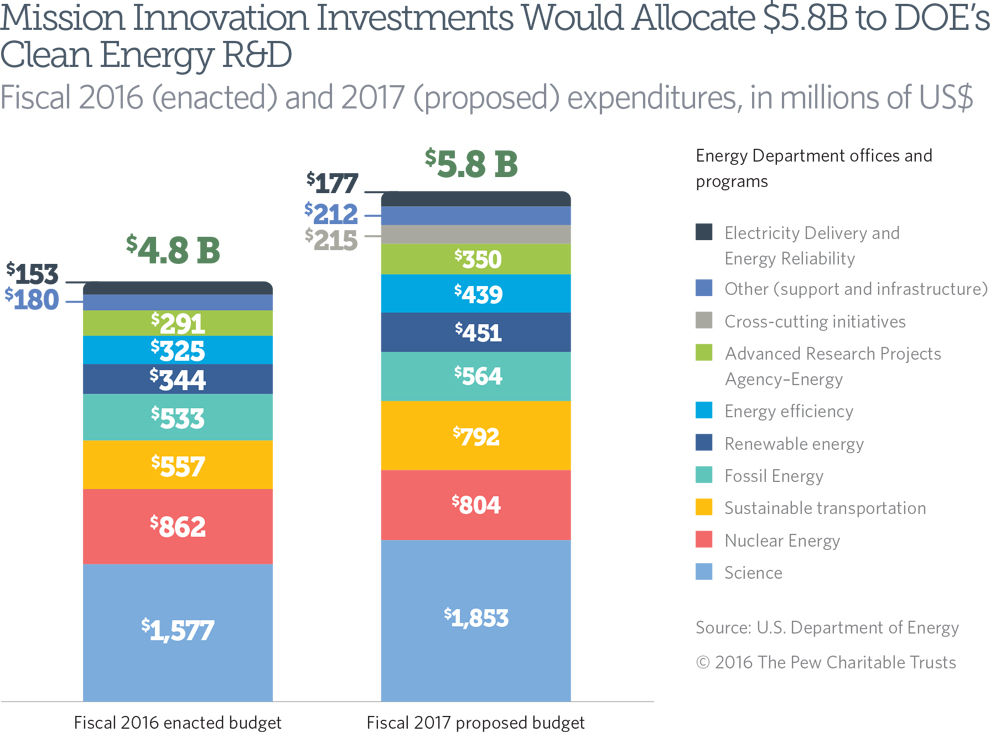Mission Innovation Could Raise GDP $8.6 Billion This Fiscal Year
Congressional support is critical to advancing the clean energy industry

More than 20 nations announced a new approach to energy innovation by forming a global partnership in 2015 to double R&D in early-stage clean energy technologies by the end of 2020. This effort is aptly named Mission Innovation.
© Pedro Castellano / Getty Images
For every dollar spent on clean energy research and development (R&D), $1.60 is created in other parts of the economy, contributing a projected $8.6 billion to the nation’s gross domestic product (GDP) this fiscal year. That’s according to an analysis by Pew and research partner ICF International Inc. that measures the economic impact of the Energy Department’s fiscal year 2017 budget proposal for Mission Innovation. The DOE initiative seeks to double R&D spending on early-stage clean energy technologies. The agency is requesting an investment of $5.8 billion—a $1 billion increase from fiscal 2016 toward that goal.
Pew and ICF found other potential economic gains this fiscal year if Congress meets the department’s budget request for Mission Innovation: $5.6 billion in wages and benefits and $1.3 billion in federal and $540 million in state and local tax revenue.
Innovation has been an economic driver since our country’s inception, spurring new industries, jobs, and advancements. Over the years, government has made significant investments in early stage R&D, particularly to address industrial, technological, health, and national security concerns. The return on investment has been substantial. Economists recognize that up to 80 percent of modern fiscal growth comes from technological innovation—the process of developing knowledge and harnessing those discoveries to create better commercial products, more competitive industries, and well-paying jobs.
More than 20 nations announced a new approach to energy innovation by forming a global partnership in 2015 to double R&D in early-stage clean energy technologies by the end of 2020. This effort is aptly named Mission Innovation. The pact is complemented by the Breakthrough Energy Coalition, a group of 28 high-net worth individuals from 10 countries dedicated to supporting the initiative by building mechanisms to analyze potential investments coming out of the research pipeline, creating investment vehicles to facilitate those investments, and growing the community of investors who join the project.
Although Pew’s new research demonstrates the short-term economic boon of clean energy R&D investment, even greater payoffs exist in the long run, including improved technologies, more affordable products, and innovations. For example, dedicated R&D helped to dramatically lower the cost of clean energy technologies in today’s marketplace. Since 2008, wind energy production has tripled while prices plummeted 40 percent. Similarly, the costs of more efficient LED lightbulbs and large-scale solar systems declined 90 and 60 percent, respectively, while deployment for both increased twentyfold. Enhanced and sustained funding for clean energy technologies lays the foundation for additional breakthroughs.
Federal investment is vital to spurring technological innovation, and the United States should prioritize energy R&D to ensure that U.S. scientists, innovators, entrepreneurs, developers, and manufacturers remain competitive. Pew and ICF’s new findings demonstrate that Mission Innovation activities would produce significant economic benefits in a single year, indicating the potential for future gains as these early-stage R&D investments lead to commercialization and deployment. When lawmakers return to Congress after the election, fully funding clean energy R&D programs for the remainder of the fiscal year should be a top priority. And the next administration should continue to follow through with the U.S. commitment to Mission Innovation.
Phyllis Cuttino directs Pew’s clean energy initiative.









